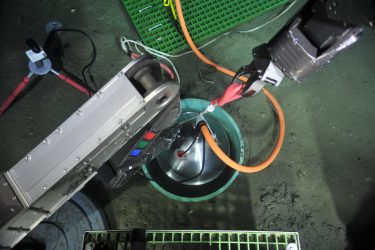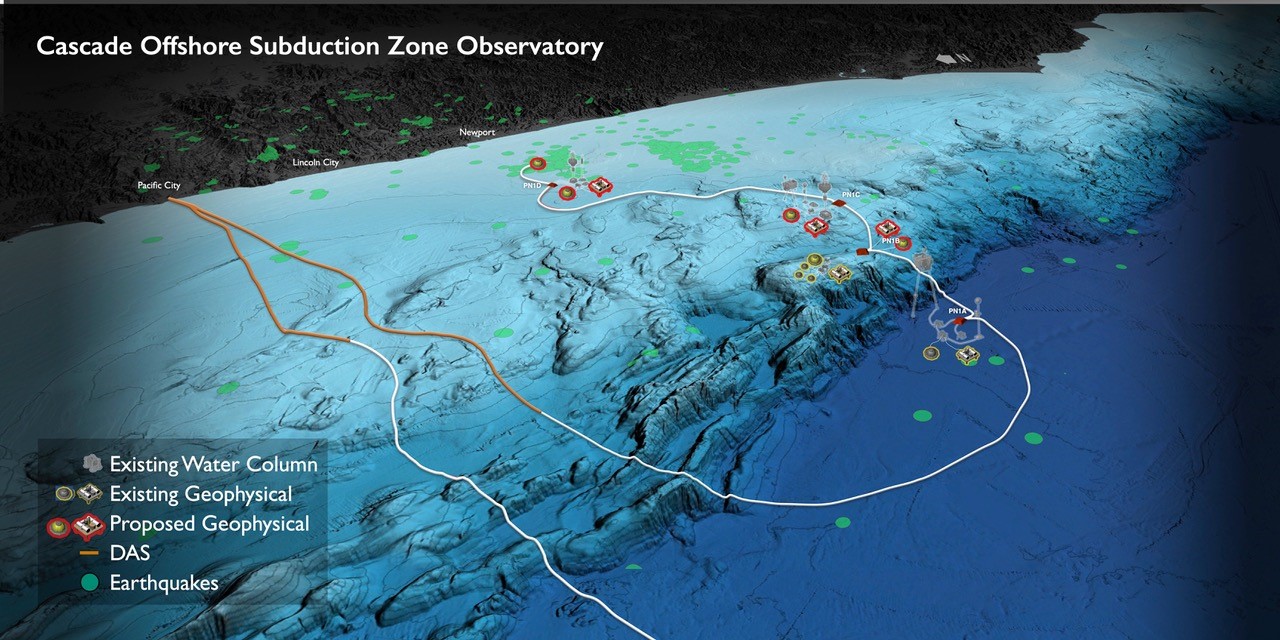
Scientists and engineers from the UW School of Oceanography, Department of Earth and Space Sciences and the Applied Physics Lab, along with partners at Scripps Institution of Oceanography, recently were awarded more than $10 million to build an underwater observatory in the Cascadia subduction zone. The funding comes from the National Science Foundation and aligns with larger efforts to better understand subduction zones more broadly.
“There’s a huge amount of interest in subduction zones, from Sumatra to Chile,” said oceanographer William Wilcock, one of several investigators on this project. “Because of the risks and hazards of subduction zones, the National Science Foundation and others have invested in studies to understand a wide variety of subduction zones because they all behave a bit differently and can have devastating impacts.”
Subduction zones are found around the world where tectonic plates collide. They are capable of producing massive earthquakes – in some cases, magnitude 9.0 and greater – with catastrophic consequences. The team of researchers will focus on the Cascadia subduction zone, whose most recent substantial earthquake was in 1700. Not only did the ground shake violently during that event, but it also unleashed a deadly tsunami. Although no one knows when, a major earthquake will happen again and have an enormous impact on life and property in the Pacific Northwest.
In this project – named “Creating an Offshore Subduction Zone Observatory in Cascadia (COSZO) with the Ocean Observatories Initiative Regional Cabled Array” – researchers and engineers will deploy numerous geohazard sensing instruments, including seismic sensors and seafloor pressure gauges, ultimately producing real-time data to shed light on subduction zone activity. The pressure gauges will be secured directly to the seafloor, many with the ability to measure pressure changes from the seafloor moving up or down within “a millimeter over a year in a thousand meters of water,” according to Wilcock. The seismometers and pressure gauges can also enhance the capabilities of early warning systems, such as ShakeAlert for earthquakes, and for tsunamis.
Yet even though the Cascadia subduction zone has catastrophic capabilities, it is generally more still than others.
“Cascadia is a very quiet subduction zone, which is unusual,” said David Schmidt, a seismologist at UW and another project collaborator. “Scientists debate about why that is and what it tells us about subduction zones. There could be low levels of seismicity out there, but we don’t have instruments there to see them. If there are smaller events, we’d like to detect them to yield new insights as to what’s happening.”
What will this observatory look like? The instruments will be installed anywhere between 250 feet to more than 3,500 feet below the ocean’s surface. Most will be on the seafloor, but the seismometers will be buried in 24-inch-diameter pipes. Any sediments retained within the pipe are removed, and the seismometers are placed inside the pipe encased in a titanium sphere. Engineers make sure the seismometers do not touch the pipe’s sides, allowing them to “float” among glass beads that are then filled to the pipe’s brim. A cable will emerge from the top and plug into a junction box nearby that supplies it with power and internet connectivity to transmit data back to shore. Researchers aim to have their first set of instruments in the water by summer 2026.
Creating this subduction zone observatory is possible because it taps into the enormous investment made by the National Science Foundation in the Ocean Observatories Initiative Regional Cabled Array (OOI-RCA), of which the University of Washington already plays a leading role. The cabled array currently brings power and internet into the ocean offshore of Newport, Oregon. The new subduction zone observatory will plug into this network.
“The concept of the OOI-RCA project was always to be expandable,” said Mike Harrington, a senior principal engineer at the Applied Physics Lab. “It was built with extra power, network bandwidth and plug-in ports. This project is the largest yet to take advantage of this aspect of the system. It will also significantly expand the footprint of instrumentation on the system.” Harrington notes this project also provides an opportunity to refresh some of the designs used in the OOI-RCA, some of which are over a decade old.
The existence of the cabled array has another fortuitous benefit—its location. “We’re taking advantage of the fact that the cabled array marches across the subduction zone,” said Schmidt. “It provides the infrastructure that can be used for earthquake early warning. The Gordon and Betty Moore Foundation supported a cost analysis on what it might take to cover the whole subduction zone in seismometers, and that would cost several hundred million dollars. This is a demonstration project of sorts—it’s a start.”
Training is a critical component of the project which includes field research for 16 UW undergraduate students over three summers, giving them experience with engineering and maintenance cruises, numerous research projects and the unique opportunity to spend time at sea. Graduate students will conduct quality assessments of the data, and at the end of the project an early career workshop is planned to introduce researchers to the massive capabilities of the observatories and develop tools to analyze the data. Importantly, information collected from this project will be freely available to anyone who can use them.
“I hope this is the start of a real push to get more observations off the coast,” said Wilcock. “The cabled array was designed to be expandable, so we can continue to use it to add additional experiments that can collect real-time data over a larger area. And we can definitely employ new technologies, like distributed acoustic sensing systems. There are lots of exciting possibilities we can imagine in the next 10 years and beyond.”

More information about projects related to the Cascadia subduction zone:
OOI Regional Cabled Array
Early Warning Cascadia Offshore System

